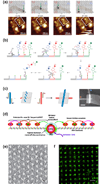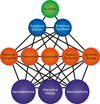Beyond DNA origami: the unfolding prospects of nucleic acid nanotechnology
- PMID: 22131292
- PMCID: PMC3360889
- DOI: 10.1002/wnan.170
Beyond DNA origami: the unfolding prospects of nucleic acid nanotechnology
Abstract
Nucleic acid nanotechnology exploits the programmable molecular recognition properties of natural and synthetic nucleic acids to assemble structures with nanometer-scale precision. In 2006, DNA origami transformed the field by providing a versatile platform for self-assembly of arbitrary shapes from one long DNA strand held in place by hundreds of short, site-specific (spatially addressable) DNA 'staples'. This revolutionary approach has led to the creation of a multitude of two-dimensional and three-dimensional scaffolds that form the basis for functional nanodevices. Not limited to nucleic acids, these nanodevices can incorporate other structural and functional materials, such as proteins and nanoparticles, making them broadly useful for current and future applications in emerging fields such as nanomedicine, nanoelectronics, and alternative energy.
Copyright © 2011 Wiley Periodicals, Inc.
Figures






Similar articles
-
Organizing DNA origami tiles into larger structures using preformed scaffold frames.Nano Lett. 2011 Jul 13;11(7):2997-3002. doi: 10.1021/nl201603a. Epub 2011 Jun 23. Nano Lett. 2011. PMID: 21682348 Free PMC article.
-
Programmable self-assembly of three-dimensional nanostructures from 10,000 unique components.Nature. 2017 Dec 6;552(7683):72-77. doi: 10.1038/nature24648. Nature. 2017. PMID: 29219968 Free PMC article.
-
Designing a bio-responsive robot from DNA origami.J Vis Exp. 2013 Jul 8;(77):e50268. doi: 10.3791/50268. J Vis Exp. 2013. PMID: 23893007 Free PMC article.
-
Self-assembled Nucleic Acid Nanostructures for Biomedical Applications.Curr Top Med Chem. 2022;22(8):652-667. doi: 10.2174/1568026622666220321140729. Curr Top Med Chem. 2022. PMID: 35319373 Review.
-
Computational Approaches to Nucleic Acid Origami.ACS Comb Sci. 2015 Oct 12;17(10):535-47. doi: 10.1021/acscombsci.5b00079. Epub 2015 Sep 17. ACS Comb Sci. 2015. PMID: 26348196 Review.
Cited by
-
Systems approaches for synthetic biology: a pathway toward mammalian design.Front Physiol. 2013 Oct 9;4:285. doi: 10.3389/fphys.2013.00285. eCollection 2013. Front Physiol. 2013. PMID: 24130532 Free PMC article.
-
Structural and Functional Stability of DNA Nanopores in Biological Media.Nanomaterials (Basel). 2019 Mar 29;9(4):490. doi: 10.3390/nano9040490. Nanomaterials (Basel). 2019. PMID: 30934927 Free PMC article.
-
Electron Microscopic Visualization of Protein Assemblies on Flattened DNA Origami.ACS Nano. 2015 Jul 28;9(7):7133-41. doi: 10.1021/acsnano.5b01841. Epub 2015 Jul 13. ACS Nano. 2015. PMID: 26149412 Free PMC article.
-
P-Stereodefined phosphorothioate analogs of glycol nucleic acids-synthesis and structural properties.RSC Adv. 2018 Jul 11;8(44):24942-24952. doi: 10.1039/c8ra05568h. eCollection 2018 Jul 9. RSC Adv. 2018. PMID: 35542141 Free PMC article.
-
Spatiotemporal dynamics of DNA nanocage uptake in zebrafish embryos for targeted tissue bioimaging applications.Nanoscale Adv. 2023 Apr 17;5(9):2558-2564. doi: 10.1039/d2na00905f. eCollection 2023 May 2. Nanoscale Adv. 2023. PMID: 37143798 Free PMC article.
References
-
- Seeman NC. DNA in a material world. Nature. 2003;421:427–431. - PubMed
-
- Voet D, Voet JG. Biochemistry. 4th ed. New York: J. Wiley & Sons; 2011.
-
- Paabo S, Poinar H, Serre D, Jaenicke-Despres V, Hebler J, Rohland N, Kuch M, Krause J, Vigilant L, Hofreiter M. Genetic analyses from ancient DNA. Annu Rev Genet. 2004;38:645–679. - PubMed
-
- Mattick JS, Taft RJ, Faulkner GJ. A global view of genomic information--moving beyond the gene and the master regulator. Trends Genet. 2010;26:21–28. - PubMed
Publication types
MeSH terms
Substances
Grants and funding
LinkOut - more resources
Full Text Sources
Other Literature Sources

